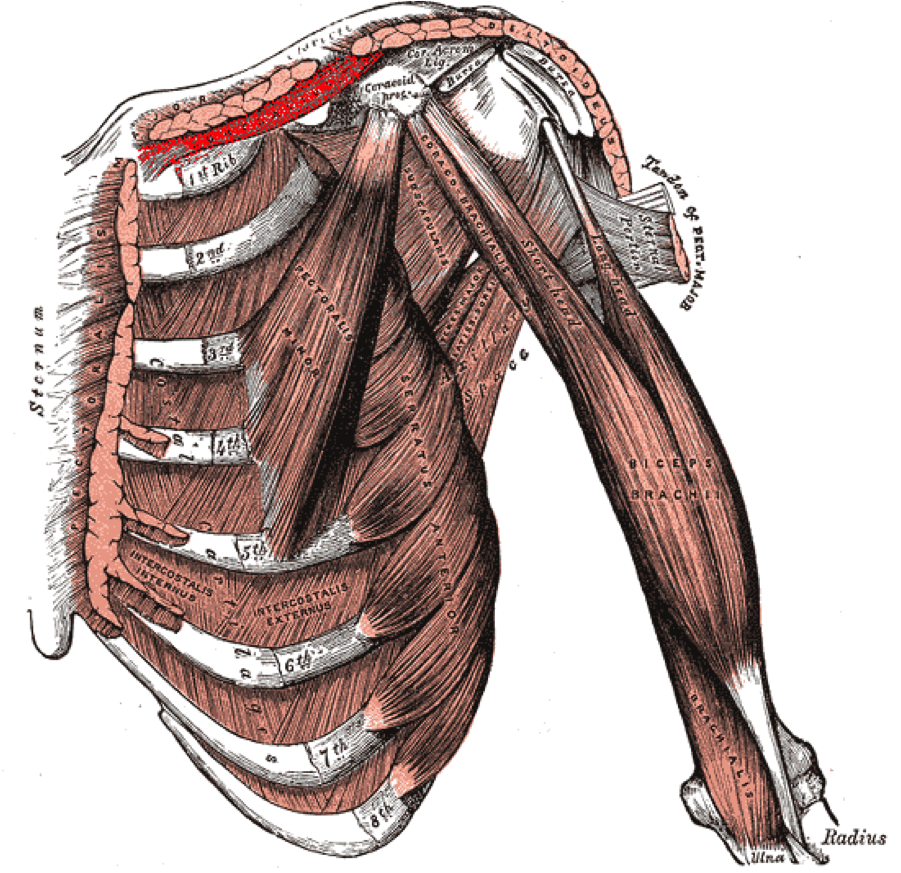
Beneath the clavicle, lies a small, rather demure muscle often left out of discussion when it comes to overall shoulder health. The subclavius, triangular in shape, is like a distant relative – it has its connection to the pectoral family and surrounding shoulder muscles, but its level of participation in the family affairs seems a bit ambiguous. “Sub” meaning under and “clavius” referring to the clavicle, the muscle name cleverly reflects its precise location within the chest cavity. This secondary muscle may seem to have little impact on shoulder health, but as you read further, the integrative role of the subclavius is quite impressive.

The subclavius originates high on the front of the chest, at the first rib and junction of the costal cartilage. It extends up a little posteriorly along the underside of the clavicle and inserts specifically to a groove on the inferior surface, middle one-third section of the clavicle known as the subclavian groove. In humans, this muscle is not only challenging to see, but it is also very difficult to isolate. But in four legged animals, such as a horse, the subclavius is larger and much more defined as it stabilizes the clavicle and shoulder girdle. This stability allows the animal to power from one move to the next, place to place.
So what does the subclavius muscle do and how does it integrate within the shoulder girdle?
Let’s first consider the primary objective of the shoulder girdle and our challenges with it. In the article, “Pivotal Places: Help for Problem Shoulders, “by Tom Meyers, he explains that, “the human shoulder was designed primarily for mobility and not stability…various problems such as hypermobility, friction and displacement are common problems. In addition, even slight displacements of the pelvis, lumbars, ribs, spine, neck or head may have a deleterious effect on shoulder function, especially when multiplied over months or years.” Meyers also discusses that there are three major points in the shoulder where certain muscles act as “pivots” in facilitating shoulder movement. The imbalances between these pivotal muscles can often lead to trigger points, faulty shoulder patterns and general dysfunction. These three crucial “pivotal muscles” are the subclavius, pectoralis minor, and teres minor, which I now visualize as the “Bermuda triangle” of the shoulder girdle.
Check back on Friday to learn how our daily habits may impact the subclavius and learn valuable self-care strategies to maintain healthy shoulder function.
Discover the Yoga Tune Up shoulder pain solutions
Watch they QuickFix Online Shoulder Video
Learn more about the YTU At Home Program












Such a small but important shoulder stabilizing muscle. Thank you for sharing! I will be sure to check out the article you referenced as well.
As someone who deals with scoliosis in both cervical and lumbar areas, I love when the small muscles are brought to the forefront! Once you realize how everything is connected from head to toe, you tend to understand how even the small “insignificant” muscles add to the entire picture.
Your anatomy lesson of this muscle was great! You used the YTU language of verbs and adjectives well and made it interesting. All the small muscles get forgotten and you brought it up from “down under.” Thanks
Looking forward to learning more in the next article! Thank you.
So timely to have found this article– I was just asking myself last what the subclavicle muscle does. Very interesting that the subclavicle acts as a pivot to shoulder movement– I had no idea!
Very interesting tidbit about the “Bermuda Triangle” of the shoulder formed by the subclavius, pec minor and trees minor. Thanks for this blog!
I didn’t realize the role that the subclavius played in shoulder movement looking forward to reading more .
I was a bit warry of the stretch that was in the video but I just tried it and it felt really really good. It was a deep controlled stretch and you can stay in that position and breath into it. It is such a good chest opener as well. It actually inspired me to create a mini session right after I tried the stretch for a longer period of time, the second time around trying it. I guess I didn’t realize how good it feels to open up your chest because aside from the health benefits, the mental aspect of being open hearted and opening the chest are a good representation of what you are trully practicing on your mat- the practice of opening your heart and mind.. the awareness.
So looking fw to reading more!!!
Wow, Amy! Suffering for decades from posture-related shoulder pain, I’ve searched volumes for the answer. Not once did I read about the pivotal role the subclavius plays in shoulder movement. Even though my shoulder is “better,” I’m still an enthusiastic student of shoulder dysfunction. I’m excited to learn more about this and can’t wait to read the next installment. 🙂